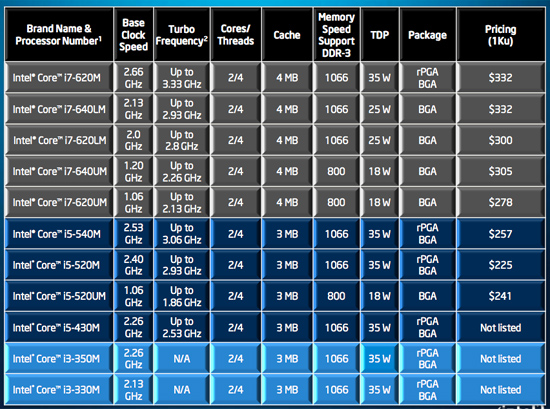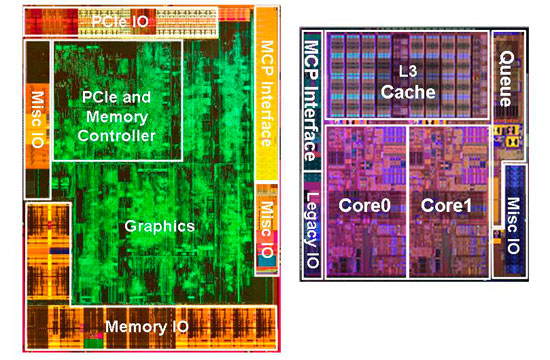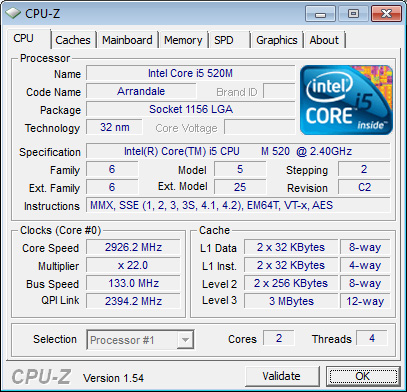Apple's 15-inch Core i5 MacBook Pro: The One to Get?
by Anand Lal Shimpi on April 14, 2010 10:38 PM EST- Posted in
- Mac
- MacBook Pro
- Arrandale
- Core i5
- Laptops
Faster, Not Slower
The 15-inch and 17-inch MacBook Pros offer your choice of Core i5 or i7 processors. If you follow Intel’s model numbers, you can get either a Core i5 520M, 540M or Core i7 620M. These chips run at 2.40GHz, 2.53GHz or 2.66GHz by default.
Wait! But the old 15-inch MacBook Pro ran at 2.53GHz, 2.66GHz or 2.80GHz by default. These new models are slower! After reading that a few times online yesterday, I knew it was time for a quick refresher on microprocessor architecture and performance.

Intel's Arrandale Lineup
There are three ways we can improve CPU performance these days: increase clock speed, increase IPC or increase thread count. The first improvement is the obvious one. Keep all other variables the same, just make the chips run at a higher frequency. The second one requires that we increase the amount of work our CPU does in each clock cycle (increasing the number of instructions completed per clock, or IPC). And the third one is to simply increase the number of simultaneous threads our CPU can handle, either through multiple cores or multiple threads per core.
With Arrandale, the mobile Core i5 and i7, Intel actually used all three tricks to improve performance.
I’ll start with the middle improvement: increasing IPC. Arrandale brings a dual-channel memory controller on-package (it’s actually on the GPU and not the CPU as you may remember). This improves bandwidth which in turn keeps the CPU cores fed with data and thus increases overall IPC.

The Arrandale die. Graphics on left, CPU on right.
The cache hierarchy has changed quite a bit since the Core 2 days. Instead of a large shared L2 cache, each of the two Arrandale cores have their own private 256KB L2 cache. The cache is the fastest of any desktop CPU today requiring only 10 cycles to access it. As I wrote in the past, the L2 is quickly becoming the new L1 so low latency access matters more than size. The catch-all cache moves down a level and Arrandale has a large 4MB L3 cache. On the Core i7s you get the full 4MB, while the i5s disable 1MB leaving you with 3.

There are some instruction and execution level improvements as well, which I’ve detailed here and here. Specific to Arrandale (and the rest of the Westmere family) are new AES instructions designed to accelerate encryption/decryption operations.
The takeaway here is any slight drop in default clock speed is at least partially negated by the increase in performance per clock. If that’s not enough, Arrandale also brings Turbo Boost to Intel’s mobile chips.
These Core i5 and i7 processors have about a million transistors dedicated to power management. It’s a little section of the CPU called the PMU (Power Management Unit). The PMU monitors CPU temperatures, current draw and power consumption. Based on these inputs as well as the current load on the CPU, the PMU can tell the rest of the CPU to increase its clock frequency. The CPU is allowed to increase its operating frequency in 133MHz steps up to a predefined max speed. The max speed is determined by Intel as well as the number of cores that are actively doing work on the chip.
The whole process works like this. If you have all cores active and the workload they’re running isn’t maxing out the CPU’s specified current or power draw, the cores can run at a higher frequency. If you have only one core active, the other core is power gated (effectively shut off) and the active core is allowed to turbo up several bins as long as it remains within its current, temperature and power limits.
The result is that most of the time your 2.40GHz Core i5 runs at 2.66GHz, and if you’re only running single threaded applications you’ll see it bounce from 2.66GHz to 2.80GHz and 2.93GHz. So even if the IPC improvements brought on by Arrandale weren’t enough, you’ll rarely run at your base clock speed when you need the performance. Intel’s Turbo Boost works beautifully in practice and the transition to OS X seems to have gone well.

The 2.40GHz MacBook Pro running at 2.93GHz thanks to Turbo
The final vector for performance improvement is by increasing the number of threads your CPU can work on at once. Threads are nothing more then collections of instructions, which themselves are the basic work units of any CPU. The more threads you can actively complete in parallel, the higher your overall CPU performance.
All Arrandale based Core i5 and i7 CPUs are dual-core processors, that’s two threads right there. Each core however can work on two threads at the same time thanks to Intel’s Hyper Threading bringing us up to four total threads on the new MacBook Pro. Two of those threads are virtual and are simply designed to occupy any idle resources on a core. Hyper Threading doesn’t give the same performance boost as you’d get from four cores, but what it does give you is better-than-dual core performance without the power requirements of four physical cores. For a notebook designed with portability in mind, the tradeoff is ideal.

The downside to all of this? Only the 15-inch and 17-inch models get Arrandale, the 13-inch MacBook Pro sticks with the old Penryn derived Core 2 Duo architecture. If you were holding out for a 13-inch Arrandale model, you’ll have to keep waiting.
| Apple's 2009 Lineup | 13-inch MacBook Pro (Early 2010) | 13-inch MacBook Pro (Late 2009) |
| CPU | Intel Core 2 Duo 2.40GHz | Intel Core 2 Duo 2.26GHz |
| Memory | 4GB DDR3-1066 | 2GB DDR3-1066 |
| HDD | 250GB 5400RPM | 160GB 5400RPM |
| Video | NVIDIA GeForce 320M (integrated) | NVIDIA GeForce 9400M (integrated) |
| Optical Drive | 8X Slot Load DL DVD +/-R | 8X Slot Load DL DVD +/-R |
| Screen Resolution | 1280 x 800 | 1280 x 800 |
| USB | 2 | 2 |
| SD Card Reader | Yes | Yes |
| FireWire 800 | 1 | 1 |
| ExpressCard/34 | No | No |
| Battery | 63.5Whr | 60Whr |
| Dimensions (W x D x H) | 12.78" x 8.94" x 0.95" | 12.78" x 8.94" x 0.95" |
| Weight | 4.5 lbs | 4.5 lbs |
| Price | $1199 | $1199 |










114 Comments
View All Comments
anactoraaron - Thursday, April 15, 2010 - link
Arrandale CULV 13-14" 1440x900 res with discrete ATI 5770mobile + GPU switching.... Imagine having up to 10+ hrs battery life for light internet, word processing work related tasks, being able to watch 2-3 dvd's on battery and then plugging in to game on very high for almost every game! CPU would be 1.3-1.5ghz on battery and "prefer" to run everything single threaded and would run upwards of 2.0ghz "preferring" to be multi-threaded plugged in. That's what I'm waiting for.... the next gen of CULV + Centrino. Can't wait.By the way, it's pretty sad that even you Anand are making comments on Apple's prices (since you love Apple the way you do). Guess all relationships that are good eventually become more "Love-Hate"
l0ts - Thursday, April 15, 2010 - link
I Wonder what difference can You find between GT330M and GT240M.I checked my GT240M in GPU-Z and looks like i got "GT330M "with higher clocks. In six months i'll probably have GT420M. :)
Thanx NVIDIA!
Jamahl - Thursday, April 15, 2010 - link
Who buys this overpriced garbage?TEAMSWITCHER - Thursday, April 15, 2010 - link
Myself, and a lot of people. I have a late 2006 MacBook Pro that was the first with a Core 2 Duo chip. I have been waiting for the first MacBook pro with a Core i5/i7 processor. This new machine looks exactly like the replacement I have been waiting for. Thank you Anand for the great (and very timely) review.ppayne - Sunday, April 25, 2010 - link
I buy Macs and am happy to. I run a business and the improved reliability of the Mac means they pay for themselves very quickly. I use my laptop about 8 hours a day (that's on top of my normal work, which I use a Mac Pro for) and any improvement in my workflow is worth a paltry $2000 to my company. If we had PCs at my company I'm sure we'd have a tech guy on payroll who kept things running by now (15 employees). Since I can literally take a hour a month to go around and make sure all updates are run on our Macs instead, there's a pretty clear savings over options we could choose (Windows, "free" Linux etc). Time, convenience, and reliability are actually worth *some* money you know?Not everyone is a college student/hobbyist/penny pinching type, although clearly you (and other commenters here) are hating for the sake of hating. For the record, I do PC software development and database work on the Mac and love the irony of not having to keep crap PCs around work to get work done.
rumimonkey - Thursday, April 15, 2010 - link
I'm curious for Anand's (or others') thoughts regarding the glossy screens... I'm looking to get my first MBP, and would prefer the 13" (in spite of the C2D). However, I was hoping for a matte option on the smaller model. Is this litmus test really good enough: indoor = glossy, outdoor = matte? I want the 13" because I'd like to be truly mobile, and thus will be beholden to variable lighting conditions. And so if I'm in a public (indoor) place trying to write or read online, what will my experience be? Or if I'm working on the couch at home with the blinds open (hey, I like sunshine), would the gloss drive me bonkers and cause eye strain? Thanks in advance to all who (hopefully) respond with comments and recommendations.kmmatney - Thursday, April 15, 2010 - link
I have a Dell with the upgraded, glossy screen, and its great in all situations indoors. As long as you can avoid any direct reflections from light sources, a glossy screen is much better indoors, IMO. I've been able to use mine outdoors as well - just need to find some shade.T2k - Thursday, April 15, 2010 - link
... and you can answer your question, which one to get. :)http://bit.ly/acer750
quiksilvr - Thursday, April 15, 2010 - link
Actually, if you get the base 15" model, its $150 extra, because they don't offer 320GB HDD at 7200rpm.That is a complete insult. Not only are these things ridiculously overpriced (and their performance isn't even that great for the price either), their upgrades are an insult. Its not like these are magical iPod HDDs. These are the SAME HDDs available on HP and Dell computers. At HP, you can upgrade from a 160GB 5400RPM HDD to a 250 7200RPM HDD for only $30.
And don't even get me started on their lack of ports. No SD slot on the 17" model? No eSATA? No Blu Ray? Correct me if I'm wrong, but aren't these laptops intended for the PROfessional field?
ReaM - Friday, April 16, 2010 - link
I agree with you.I have had 10 macs in my life, currently macbook pro and imac.
This update is ridiculous. The extra cost for the - what now is standard display - is hilarious.
The only update worth considering is the base 13 inch. But still no i5 nor i3 in it and no display bump up.
As I wrote, for 1700 buck you can build i7 980X system (hackintosh, if you will) - just as a comparison.
The current macs are not worth the money.
Last worthy update was the when unibodies were introduced. But since then, two years went by and nothing changed, except of higher price